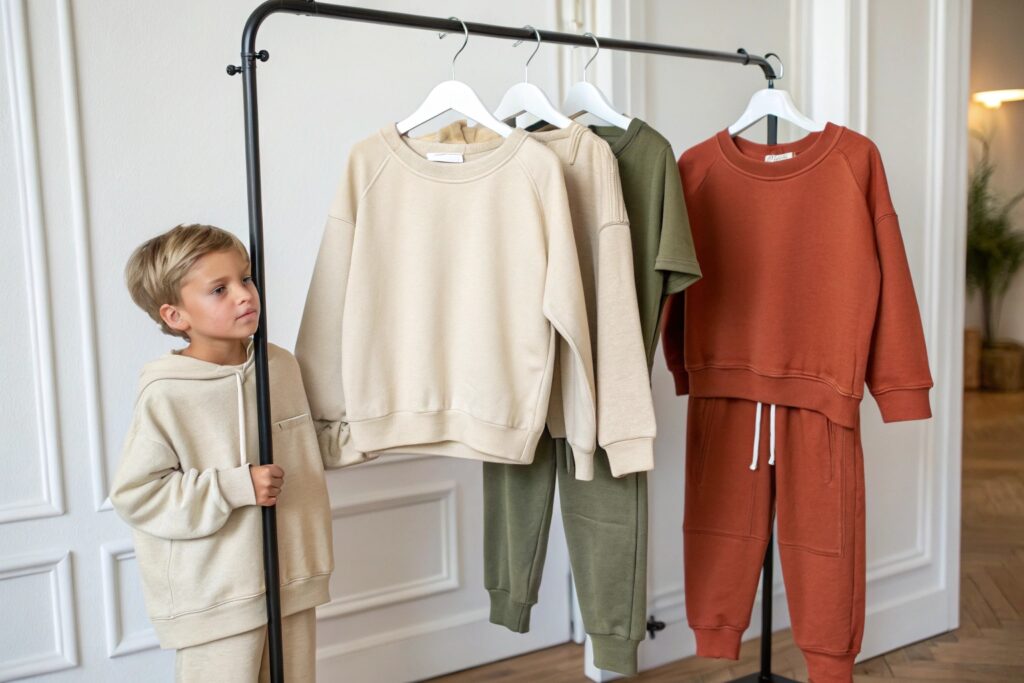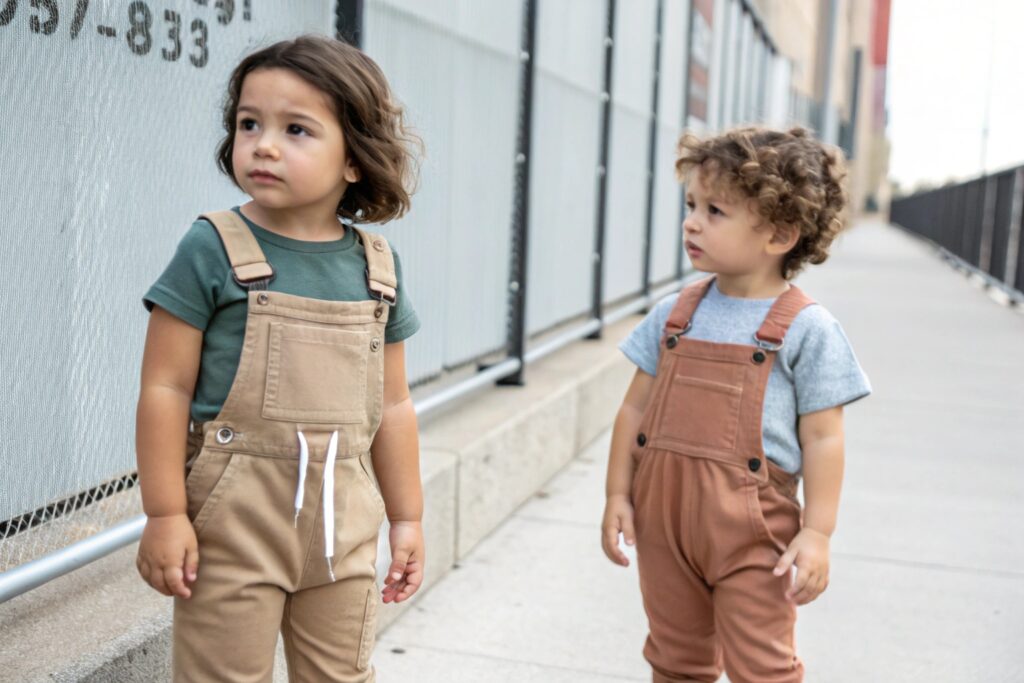Dressing multiple kids often means double the shopping, triple the laundry, and an overflowing closet.
Capsule wardrobes let siblings share essentials across ages and genders—cutting costs, clutter, and confusion.
When I started helping clients develop kidswear for larger families, the most frequent request was simple: “Can we make it easier for siblings to share clothes?” Capsule logic was the answer.
Building Gender-Neutral Wardrobes for Siblings?
Every family with sons and daughters struggles with hand-me-downs that don’t match or feel “too girly” or “too boyish.”
Gender-neutral capsule wardrobes use timeless cuts and universal colors so siblings can share clothing without hesitation.

What design principles help create gender-inclusive styles that kids will love wearing?
Start with shape. Boxy tees, elastic pants, and oversized sweatshirts work well for both boys and girls. Avoid form-fitted cuts or “cute-only” trims. Instead, emphasize play-readiness and comfort.
Fumao Clothing focuses on cuts that fit wide age and body ranges. For example, our hoodie designs have dropped shoulders, making them easier to size across growing bodies. We also avoid deep v-necks or stylized ruffles unless requested.
When working with global clients, I always recommend building these three categories into any kidswear capsule:
- Everyday Basics: solid tees, joggers, zip hoodies
- Outdoor Layers: neutral raincoats, fleece jackets
- Sleep & Lounge: soft pajama sets, oversized tops
These pieces not only work for either gender, but they also layer easily into themed capsule kits—great for online merchandising or bundled B2B orders.
How do color palettes and prints influence the gender neutrality of sibling wardrobes?
Color does more than decorate—it signals identity. And kids pick up on that fast. So when building shared wardrobes, avoid colors that culturally lean hard in one direction (like bubblegum pink or firetruck red). Instead, go for:
| Color Tier | Suggested Colors | Notes |
|---|---|---|
| Base | Beige, Navy, Gray | Foundation for mixing |
| Accent | Teal, Mustard, Olive, Coral | Adds character, not division |
| Prints | Stripes, Dots, Abstract Shapes | Avoid animals or slogans |
I’ve worked with clients in the U.S. who’ve built entire gender-neutral kidswear collections using just five base fabrics. It’s cost-efficient, easier for marketing, and creates high parent trust—especially among eco- or minimalist-minded buyers.
Maximizing Outfit Combinations Across Ages?
Sibling wardrobes don’t just need to work across genders—they must work across size gaps too.
Smart capsule designs offer flexibility across ages, letting parents mix and match outfits between kids without buying dozens of pieces.

What garment features help clothes adapt to various sizes within sibling groups?
Adjustability is key. For our factory runs, we build these features into capsule lines meant for families:
- Stretch waists and cuffs: so pants fit longer
- Button-side tops: easier to share between sizes
- Drop hems and rolled sleeves: visual balance on taller/shorter children
- Tagless sizing: more comfortable, flexible hand-me-downs
We also recommend developing “growth-bridge” garments. These are clothes that span multiple sizes through modular design. For example, pants with double-button waists or overalls with adjustable straps. They reduce new purchases between age gaps.
Several of our clients in North America now request these pieces for their subscription capsule boxes. One pair of pants that works for two kids? That’s a value proposition parents understand immediately.
How can parents build a capsule system that works across toddler to pre-teen years?
It starts with mapping a wardrobe by size and category. Here’s a setup I recommend when sourcing for multi-child households:
| Category | Size Span | Shared Examples |
|---|---|---|
| Outerwear | 2T–6Y | Puffer vest, windbreaker jacket |
| Casual Tops | 4Y–10Y | Boxy graphic tee, ribbed long sleeve |
| Sleepwear | 2Y–8Y | Oversized cotton sets |
| Bottoms | 3Y–7Y | Elastic joggers, adjustable denim |
When families adopt this approach, they drastically reduce seasonal turnover. At Fumao Clothing, we support this with customizable bundles that fit size brackets, not fixed ages.
It’s also a great way to pitch wholesale capsule lines—especially for brands selling to larger families or homeschool communities.
Smart Clothing Investments for Growing Families?
Buying for multiple kids can feel like a constant cycle of outgrowing, restocking, and wasting money.
Capsule wardrobes shift the mindset from “buying more” to “buying smarter,” helping families invest in durable, shareable pieces.

What qualities should families look for in long-term capsule garments?
Here’s what I’ve learned from years supplying major kidswear brands: durability wins every time. Parents don’t mind paying more once if they don’t have to replace something three times.
The most reliable capsule investments include:
- Double-stitching in all stress areas
- Reinforced knees and elbows on playwear
- Color-fast fabrics that don’t fade after five washes
- Machine-wash safe with minimal shrinkage
And don’t forget finishes—soft-touch treatments, natural dyes, and non-irritating seams add value. We include all of these in our Fumao production for custom capsule lines.
I’ve also seen clients succeed with a “3-season use” promise—advertising that capsule items last through spring, summer, and fall. That’s the kind of message that cuts through in both physical and digital marketplaces.
How does investing in capsule clothing improve ROI for families over time?
Let’s do a quick math comparison, based on typical American families with two kids:
| Expense Type | Traditional Shopping | Capsule Wardrobe |
|---|---|---|
| Annual spend/kid | $400–$600 | $250–$300 |
| Items purchased/year | 40–60 | 15–20 |
| Total laundry loads | 200+ | ~120 |
| Pass-down success | Low | High |
Capsule wardrobes help reduce buyer’s remorse. And for our B2B partners, capsule lines lead to fewer returns, higher margins, and stronger customer satisfaction. Parents feel like they’re buying solutions, not just clothes.
Reducing Closet Clutter with Shared Essentials?
A cluttered closet leads to stress. For families with multiple kids, the mess multiplies quickly.
Shared capsule essentials cut the noise—turning chaotic closets into organized, low-maintenance systems.

How can parents organize shared wardrobe systems using capsule principles?
Capsule logic turns storage into strategy. Instead of sorting by child, families can sort by category:
- Bin A: Tees (fits both)
- Bin B: Bottoms (elastic/stretch)
- Bin C: Layers (sized generously)
- Hooks: Weekly outfit rotations
We’ve had clients include printable closet charts with our capsule shipments—a small touch that makes a big difference for buyers. It’s especially helpful for large or blended families who need systems more than style.
Also, labeling drawers or bins by “Use Case” (School, Home, Outside, Sleep) instead of by child can make outfit-picking more independent and efficient.
What role do multipurpose garments play in decluttering family closets?
One item, many uses—that’s the goal. And in capsule planning, multipurpose garments are gold.
At Fumao, we produce several staples designed to cover different settings:
| Garment Type | Use Case |
|---|---|
| Hooded Sweatshirt | School, Weekend, Travel |
| Soft Joggers | Sleepwear, Playwear, Lounge |
| Fleece Vest | Layer for cold, outdoor play, family trips |
The fewer pieces needed, the easier it is to keep closets clean—and kids happy.
Conclusion
Shared sibling wardrobes built with capsule logic make dressing easier, cheaper, and more sustainable. At Fumao Clothing, we help brands create collections that simplify family life while maximizing value.










